|
|
|
|
The Plates:
Vue perspective intérieure coloriée, prise sous le portique du Grand Temple
[The Hypostyle of the Main Temple of Philae Perspective View]
Artist: Jean Baptiste Le PPre (French, 1761-1844)
Engraver: Antoine Phelippeaux (French, 1767-ca. 1830)
Technique: Color Engraving
Year: 1809
Measurements: 35.6 x 54.5cm
From: France. Commission des sciences et arts d'Égypte. Description de l'Égypte. Paris: Imprimerie impériale, 1809-1828. Antiquités, Vol. 1, Plate 18. Rare Flat DT46 F8
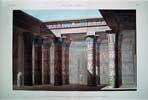 | THIS PLATE IS ONE of the most renowned and frequently reproduced engravings of the entire Description de l'Égypte. The enchanting depiction highlights the grandeur of the temple, its magnificent colors, detailed hieroglyphics, and serene Egyptian priests. The design was made by the architect Le PPre, and his profession is reflected in his precise draftsmanship of the architecture and hieroglyphics.
The text that accompanies this plate describes how the colors were faithfully reproduced in the de luxe colored edition of the Description de l'Égypte. The engraving appears to be the apogee of the scientific nature of the expedition, both in its precise depiction and method of color engraving employed. However, we know from various sources (including the text published with the plates) that this was not the temple scene that the French encountered. The illustrator cut away columns to give the viewer a clearer perspective. Moreover, the real temple was in a far more ruinous condition, and while colors were faithfully recorded, they were only copied from fragments of debris. The addition of three Egyptian figures is purely fictional. Therefore, far from being scientific, Le PPre has taken liberties and portrayed the temple as he believed it would have looked in ancient Egypt.
Lancret's contemporary account helps to illuminate the motives behind the will to reconstruct the ancient Egyptian past: “The Greeks and the Romans have possessed it [the Island of Philae] and the French army, conducted in Egypt by the General in chief Bonaparte has also taken possession of it.” The engraving is therefore a construct of the glorious ancient Egypt ruled by Pharaohs with which Napoleon wanted to associate himself, like the Greeks and Romans before him.
M.D.
|
THEBES. BYBAN EL MOLOUK, TABLEAUX DE LA SALLE DES HARPES DANS LE 5E TOMBEAU DES ROIS A L'EST
[THEBES. BYBAN EL MOLOUK, PANELS FROM THE ROOM OF HARPS, FIFTH EASTERN TOMB OF THE KINGS]
Artist: André Dutertre
Engraver: Antoine Maxime Monsaldy (French, 1768-1816)
Technique: color engraving
Date: 1812
Measurements: 42 x 58 cm.
From: France. Commission des sciences et arts d'Égypte. Description de l'Égypte. Paris: Imprimerie impériale, 1809-1828. Antiquités, Vol. II, Plate 91. Rare Flat DT46 F8
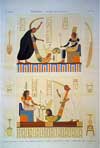 | THE PAINTINGS OF THE HARPISTS are part of an extended religious scene from the tomb of King Ramses III (c.1184-1153 B.C.), located at Thebes, in the Valley of the Kings. They were first discovered by the English archeologist John Bruce in the eighteenth century. However, the scholars who travelled with the Egyptian expedition felt it was their responsibility to study the tomb paintings again and to publish their results. They hoped to provide more accurate color engravings than the illustrations made by Bruce, and to improve upon previous studies. The scholars praised the sophistication of Egyptian music and artistic achievements, noting that the instruments were comparable to those of Europe. In their minds, the French had discovered evidence of a highly developed culture, and they drew parallels between the height of ancient civilization and the great achievements of modern France. The idea of restoring ancient Egypt's glorious past represents one way in which the French justified plans to colonize Egypt.
Another scholar associated with the Egyptian campaign, Guillaume-André Villoteau, may have contributed to these plates because of his interest in musical instruments from cultures outside Europe. Although Napoleon requested that he sing and compose songs for the campaign, Villoteau declined, pointing out that he was invited to the campaign as a musicologist and specialist for musical instruments and not as an entertainer.
E.M.
|
VUE DE L'ARC DE TRIOMPHE
[VIEW OF THE TRIUMPHAL ARCH]
Artist: François-Michel Cécile
Engraver: A.-B. Duhamel
Technique: Engraving
Year: 1818
Measurements: 29.5 x 48 cm.
From: France. Commission des sciences et arts d'Égypte. Description de l'Égypte. Paris: Imprimerie impériale, 1809-1828. Antiquités, Vol. IV, Plate 57. Rare Flat DT46 F8
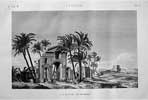 | THIS PLATE DEPICTS a romanticizing view of the remains from the triumphal arch at Antinoë (Antinoöpolis), a village founded by Emperor Hadrian on October 30, 130 A.D,. in honor of Antinus, the emperor's favorite who saved him from drowning in the Nile. It was the best-preserved Roman monument the French expedition discovered in Egypt. The damage to the façade with its missing frontal columns was sustained when builders of the Christian churches and mosques used the arch as a quarry. Vestiges of the columns' ruined bases suggest they were made of granite.
No other classical remains were found in Egypt that could compare to this building's purity of lines, angles, mouldings, and archivolts. The decorations of the three arches, entablatures, columns, pilasters, and capitals were sculpted in the Corinthian and Doric orders. The monument is admirable for its elegance, simplicity, and fine proportions.
Nestled in the landscape, there is the city of Sheikh Ibada, a modern settlement built near Antinoöpolis. The illustrators' sensitivity to depict the date palms encroaching upon the houses and surrounding the triumphal arch enhanced the picturesque appeal of the ruins of Antinoë. The expedition's interest in the triumphal arch reinforces the cause of colonialism in Egypt. It evokes the celebration of triumphs and conquests.
C.S.
|
PYRAMIDES DE MEMPHIS
[PYRAMIDS OF MEMPHIS]
Artist: François-Michel Cécile (Figure 1), Jean-Baptiste Réville (French, 1767-1825) (Figure 2)
Engraver: Jean Duplessis-Bertaux (French, ca 1747-1820) (Figure 1), Jean Louis Delignon (Figure 2)
Technique: Engraving
Year: 1822
Measurements: 52 x 41cm.
From: France. Commission des sciences et arts d'Égypte. Description de l'Égypte. Paris: Imprimerie impériale, 1809-1828. Antiquités, Vol. V, Plate 13. Rare Flat DT46 F8
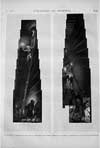 | THE ILLUSTRATIONS on this plate show two ascending corridors in perspective views, which were recorded while the French scholars explored the inside of the Great Pyramid of Cheops. Local guides, who can be identified by their decorative Oriental attire, accompany the French explorers through the pyramid. In figure 1, the architect Jean-Baptiste LePPre stands by the five-stage ladder he custom-designed for the exploration. This same ladder is located in the background of figure 2. At the top of the ladder, a figure identified as M. Coutelle enters a recess that was built above the King's Chamber to relieve weight on the room.
The pyramid had three chambers: the King's Chamber, the Queen's Chamber, and a lower chamber that the French never discovered. The King's Chamber housed the sarcophagus, while the other two were never completed and are considered to be decoys for tomb robbers. In this plate, people emerge from different areas to indicate the chamber entrances. In figure 2, a man in the foreground holds a light as he emerges from the horizontal gallery that extends to the Queen's Chamber. A figure in full military dress appears from the gallery that leads to the entrance of the pyramid, underlining that the scientific exploration of Egypt would have been impossible without the support of the French army occupying the country.
E.P.
|
VUE DU PORT ET DE LA GRANDE MOSQUÉE DE BOULÂQ
[VIEW OF THE PORT AND OF THE GRAND MOSQUE OF BOULAQ]
Artist: Charles-Louis Balzac (French, 1752-1820)
Engraver: Louise-Pierre Baltard (French, 1764-1846)
Technique: Engraving
Year: 1809
Measurements: 36.5 cm x 52 cm
From: France. Commission des sciences et arts d'Égypte. Description de l'Égypte. Paris: Imprimerie impériale, 1809-1828. État moderne, Vol. I, Plate 25. Rare Flat DT46 F8
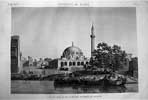 | DURING THE EIGHTEENTH CENTURY Boulaq was part of Cairo, but a separate township. The port of Boulaq served Lower Egypt as a known center of commerce. Exotic merchandise such as henna, saffron, rubber, and ivory from Arabia and inner Africa were stored within Boulaq's walled structures. Goods from Europe destined for Cairo were often received, while the wares of Upper and Lower Egypt went to Boulaq's great okels, or markets. The boats along the shoreline in the plate display such goods as bananas, pottery, and fish. The port's prosperity earned Boulaq the status as Egypt's gateway to Istanbul. The Western fascination with the Orient is expressed by the figures of three French soldiers in the foreground contemplating an Egyptian sarcophagus as it is measured by a French artist-scholar.
The Grand Mosque of Sinan Pasha, Egypt's governor, was built in 1571. The mosque consisted of a square prayer hall covered by Cairo's largest dome, with porticoes along its sides. The buttress-supported dome and the single gallery of the towering minaret are Ottoman features. The transitional area of the dome revealed a tripartite system of squinches, characteristic of Mameluke style. This fusion of styles bespeaks Egypt's cultural richness, an enduring faith, and a strong Eastern awareness of the past.
J.H.
|
COSTUMES ET PORTRAITS [COSTUMES AND PORTRAITS]
Artist: Alexandre Marcel.
Engraver: Jean Duplessis-Bertaux (French, ca. 1747-1820) and Pierre Audoin
Technique: Engraving
Year: 1817
Measurements: 45 cm. x 61 cm.
From: France. Commission des sciences et arts d'Égypte. Description de l'Égypte. Paris: Imprimerie impériale, 1809-1828. État moderne, Vol. 2, Plate K. Rare Flat DT46 F8
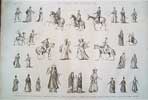
| THE MANY COSTUMES worn in Egypt at the time of the French occupation captivated the fantasy of the Western observers. The variety of dress and costume exemplified Egypt's cultural richness. Garments were apparently selected for this plate based on what they revealed about the various racial types and indigenous groups.
Military costumes, such as those in figures 1, 2, 4 and 11, illustrate the distinctions across rank, title, and status among Egyptian soldiers. Another soldier is depicted in figure 3, yet this man's dress is distinctly different from that of the previous group because he is a Janizary, or Turkish soldier. Beys, leaders of the warrior-caste that ruled in Egypt, are shown elaborately dressed with elongated swords, in figures 5 and 8. In figures 7 and 17, the slave-soldiers, or Mamelukes, wear full trousers and three-quarter-length cloaks; and in figures 12 and 15, Arab warriors dress in simpler cloaks and feature closely wrapped turbans. The properly draped and veiled female dancer in figure 13 contrasts with the exotically dressed dancer in figure 14. Women of the harem are illustrated in figures 25 and 27, adorned with elaborate garments, jewels, headdresses, and elevated shoes. Another group of women in figure 26 is shown wearing religiously prescribed protective veils and full-length robes. Costumes of the sheikhs, holy men or Arabic chiefs, are shown in figures 16, 18, 20, and 21. In figure 28, a Copt scribe, member of an ethnic group believed to have been a direct descendant of the ancient Egyptians, is portrayed as a scholar identified by his pen and inkwell. The remaining figures (6, 9, 10, 19, 22, 23, 24, 29, and 30) portray diverse costumes from various groups, adding further evidence for the variety of cultures and races in Cairo at the time of French occupation. Figures 6 and 22 are identified as Jews; 9, 29, and 30 are court officials; 23 is a Greek Orthodox priest; and 10 is a warrior on a camel.
Although the French scholars encountered a wide diversity of peoples during their exploration of Egypt, and hoped to portray each group as distinct and unique in its own ways, most of the illustrations they recorded only underscored stereotypical views of “the Oriental” by portraying each figure with cliché attributes, dress, or manner.
N.M.
|
CHAUVE-SOURIS D'ÉGYPTE
[BATS OF EGYPT]
Artist: Geoffrey St. Hilaire (French, 1772-1844)
Engraver: A. Bouquet (French, fl. 1805-1820)
Technique: Engraving
Year: 1809
Measurements: 59.5 cm x 42 cm
From: France. Commission des sciences et arts d'Égypte. Description de l'Égypte. Paris: Imprimerie impériale, 1809-1828. Histoire naturelle, Vol. I, Plate 1. Rare Flat DT46 F8
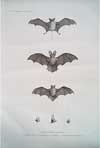
| THE HISTOIRE NATURELLE (Natural History) volumes examine animals, plants, and rocks that the French scholars discovered during the Egyptian campaign. Each plate illustrates how determined the scholars were to document their discoveries, and they assigned importance to every life form they encountered in the various regions of Egypt.
The first page of the Histoire Naturelle depicts three species of bats that the French probably encountered while exploring tombs, old buildings, or caverns.The first bat illustrated is [Taphozous nudiventris], also known as a naked-bellied tomb bat. The male version of this bat is often brown in color, whereas the female is grey. They also have light colored underbellies, and some species have white spots on the body. They measure about 6-10 cm., and their tails grow up to an additional 2-4 cm. in length.
The second bat illustrated is [Nycteris thebaica], known more commonly as the hollow-faced or slit-faced bat. These bats are very rare and inhabit only parts of Africa and the Middle East. They are easily recognizable by the structure of their muzzle, which has a deep central groove, and their large ears, which measure between 2-4 cm. They are commonly brown in colour, with lighter brown or greyish sides, and measure about 10 cm in length with 4-6 cm tails.
The third bat is [Vespertilio pipistrellus], of the family Vespertilonidae, members of which are the most common bats found in most parts of the world. They are grey, brown, red, or black in color and measure about 3.5-10 cm. long, with a tail between 2.5-6 cm. long. During the campaign, these bats had the reputation of being erratic fliers that appeared earlier than other bats in the evening and sometimes they were even spied flying during the day.
N.M.
|
Back to Top
|
|